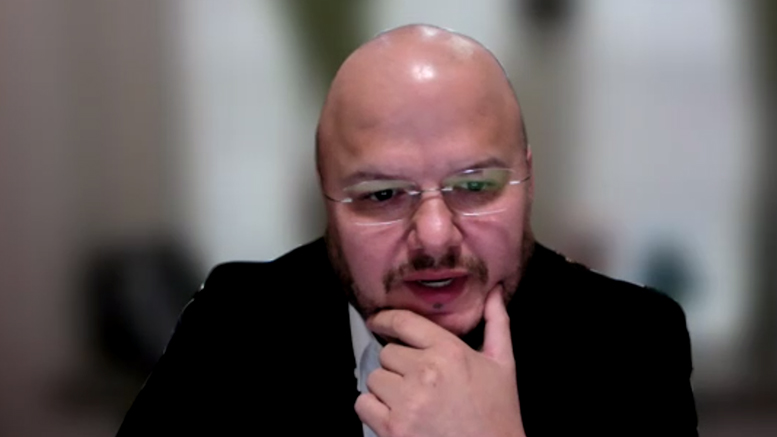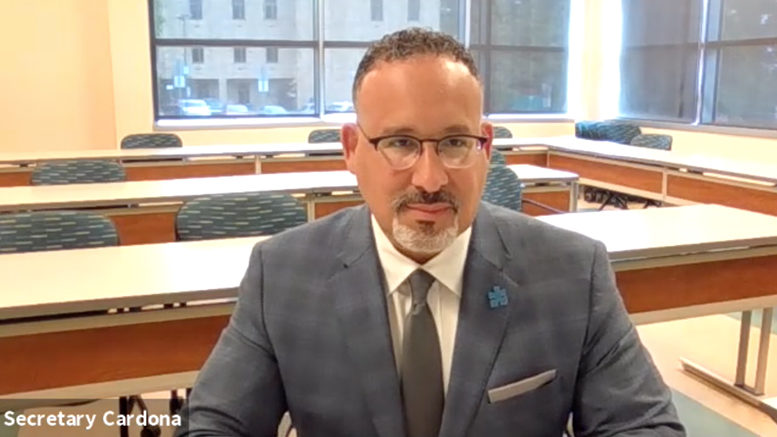U.S. Education Secretary Miguel Cardona this week emphasized that one of his priorities is to make sure pre-K-12 is connected to higher education and workforce needs, too.
“We need to make sure we are providing better pathways for our learners,” said Cardona, who spoke Monday at the Education Writers Association’s (EWA) annual National Seminar held online.
He reiterated that a good education system helps students, their families and the economy as well.
“This is going to be as much a priority for me, as secretary of education, as the pre-K-12 shifts that we have to make across the country,” he said. “I see the connection, and I know that a good education system is the best economic driver in our country.”
Cardona said a lot of work remains among schools, community colleges, businesses and other stakeholders to create viable career pathways. He noted dual enrollment, internships and other workforce-related programs are options to allow students to sample career and education paths.
Cardona also said workforce partners need to get involved earlier in students’ education.
“You can’t wait for the students to graduate to become connected. Start sitting down with educators to help develop curriculum so that the curriculum students are getting as early as middle school connects to the workforce needs,” he said.
Cardona also discussed the president’s American Families Plan, which would provide two years of free community college. In fact, he addressed the reporters’ conference after visiting the Community College of Baltimore County, where he talked to students studying occupation therapy and automotive technology.
If the proposal is enacted, “It’s going to be a shot in the arm for our country,” he said.
Staying connected
With huge drops in enrollments last fall and this spring, community colleges are more closely examining what they can do to retain students and attract new ones. Many students struggling financially opted to work instead of going to college during the pandemic, said Angela Johnson, vice president of access and completion at Cuyahoga Community College (Tri-C) in Ohio, who also spoke at the EWA conference. Tri-C has been thinking about how to connect students with good-paying jobs as they return to school so that the lost wages aren’t a challenge for them, she said.
The Cleveland college is looking at what local business sectors currently have openings and is trying to pair students’ interests in those fields. The college also is connecting with employers to see if their incumbent workers may need to upgrade their skills or help them advance on their career path.
Tri-C uses myriad ways to stay connected with students, from texting to social media, like Instagram and Snapchat. The college also increased calling students, with some success. Adding a personal touch to find out students’ goals and challenges has helped Tri-C determine what it can do to help them, Johnson said.
Tri-C has seen enrollment drop about 20% over the fall and spring terms, but so far its summer numbers are 3% to 4% above last summer. (Summer classes start June 1.) The goal for the coming fall is to return to pre-pandemic numbers, perhaps climb back to 2019 figures, Johnson said.
Last year’s high school graduates
The hardest group of potential students to reach is those who graduated high school in 2020 and opted not to attend college in the fall because of Covid, said Doug Shapiro, executive director of the National Student Clearinghouse Research Center. Those individuals don’t have counselors and teachers advising them on courses or an academic path or helping them make the transition to college, such as advising them to complete a federal student aid application.
“They’re disconnected now with education,” Shapiro said. “The longer these students stay out … it gets harder and harder to get back into even the mindset of thinking about yourself in a classroom again.”
A more personal approach
Robert Vela, president of San Antonio College (SAC), highlighted his college’s efforts to stay connected with students, such as making phone calls to students, which helped maintain retention rates. But the Texas institution also stepped up efforts to ensure continued student success by hiring more counselors and advisors and improving student supports.
“That was transformational,” said Vela, who also serves on the American Association of Community Colleges board of directors.
SAC has been intentionally intrusive in helping its students. For example, it has assigned an advisor to each of its 20,000 students, with whom they must meet, Vela said. He noted that some students previously didn’t meet once with their advisor, which resulted in students often taking more courses than they needed to graduate or that they couldn’t transfer, Vela said.

With a case management approach, advisors follow each student to help him or her select courses based on their plan of study, all the way through graduation and even into employment, he said.
“There is no option anymore,” Vela said.
SAC also has embedded mandatory tutoring in some of its most challenging courses, such as math, which has helped to scale down the number of developmental courses, Vela said.
The college is taking a similar approach to providing wraparound services so students can focus on their academics. Previously, SAC would refer students to community organizations for services such as mental health.
“They don’t go. Those students don’t go” to those outside services, he said.
SAC is also examining how it can increase childcare services to help parent students. The college is mulling a structured program similar to a Boys/Girls Club or YMCA model, Vela said.
“It’s difficult to be everything to everyone, but you have to know your students,” he said.

